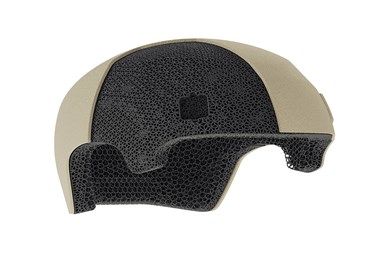Carbon Expands Resin Materials Portfolio
The three resin materials — Carbon EPU 43 and EPU 45, and Henkel Loctite IND147 — offer impact protection, highly breathable lattice geometries and a low-cost, fast alternative for producing low-pressure moldings, baking fixtures and small components with complicated geometries.
Share
Read Next
Ballistics helmet liner developed in partnership with Rice University using Carbon EPU 45. Photo Credit: Carbon
Carbon has added three resins to its material library, including Carbon EPU 43 and EPU 45, and Henkel Loctite IND147, which are now available to all Carbon customers and are validated for use on all Carbon platforms.
Carbon EPU 43 and EPU 45 are two damping elastomers now available on the Carbon idea-to-production platform. They offer new opportunities for breakthrough products in impact protection, such as padding, gloves, and helmets. However, each material provides even greater control for performance optimization with different applications.
EPU 43 is soft while offering good damping performance and excellent durability under high-cycle flexing. It can be used in applications where foam is traditionally used, but with lower density, increased airflow and much higher durability, making it well suited for applications such as comfort liners inside helmets and impact padding for safety gloves. EPU 43 prints with moderate green strength, which enables for a broad set of possible production shapes with high yield.
EPU 45 is a strain rate sensitive material that stiffens to absorb energy at higher impact rates. This enables the design of highly breathable lattice geometries tuned for comfort at low-impact speeds and energy absorption at high-impact speeds. EPU 45 has the highest green strength of Carbon’s elastomers, enabling the widest range of part shapes and lattice geometries to be printed at a high yield. It offers exceptional damping performance and printability, making it well suited for applications such as sports padding, seating and more.
Henkel Loctite IND147 is a rigid, black resin with high stiffness, high temperature resistance, dimensional stability and exceptional surface quality. It is a low-cost and fast alternative for producing low-pressure moldings, baking fixtures and small components with complicated geometries used under high heat applications in industrial, consumer and automotive markets. Additionally, because Loctite IND147 is a one-part resin, it’s easy to use with simple processing.
Loctite IND147 is a third-party resin offered by Carbon materials partner Henkel and validated to work with the Carbon platform. Henkel and Carbon are also expanding their strategic relationship to offer several new resins, which will be made available on the Carbon idea-to-production platform in 2023.
• Peter Zelinski tells us about autonomous cobot automation increasing production 3D printer output for Ford utilizing Carbon printers (includes video).
Related Content
-
Q&A With Align EVP: Why the Invisalign Manufacturer Acquired Cubicure, and the Future of Personalized Orthodontics
Align Technology produces nearly 1 million unique aligner parts per day. Its acquisition of technology supplier Cubicure in January supports demand for 3D printed tooling and direct printed orthodontic devices at mass scale.
-
3D Printing with Plastic Pellets – What You Need to Know
A few 3D printers today are capable of working directly with resin pellets for feedstock. That brings extreme flexibility in material options, but also requires greater knowledge of how to best process any given resin. Here’s how FGF machine maker JuggerBot 3D addresses both the printing technology and the process know-how.
-
Possibilities From Electroplating 3D Printed Plastic Parts
Adding layers of nickel or copper to 3D printed polymer can impart desired properties such as electrical conductivity, EMI shielding, abrasion resistance and improved strength — approaching and even exceeding 3D printed metal, according to RePliForm.















